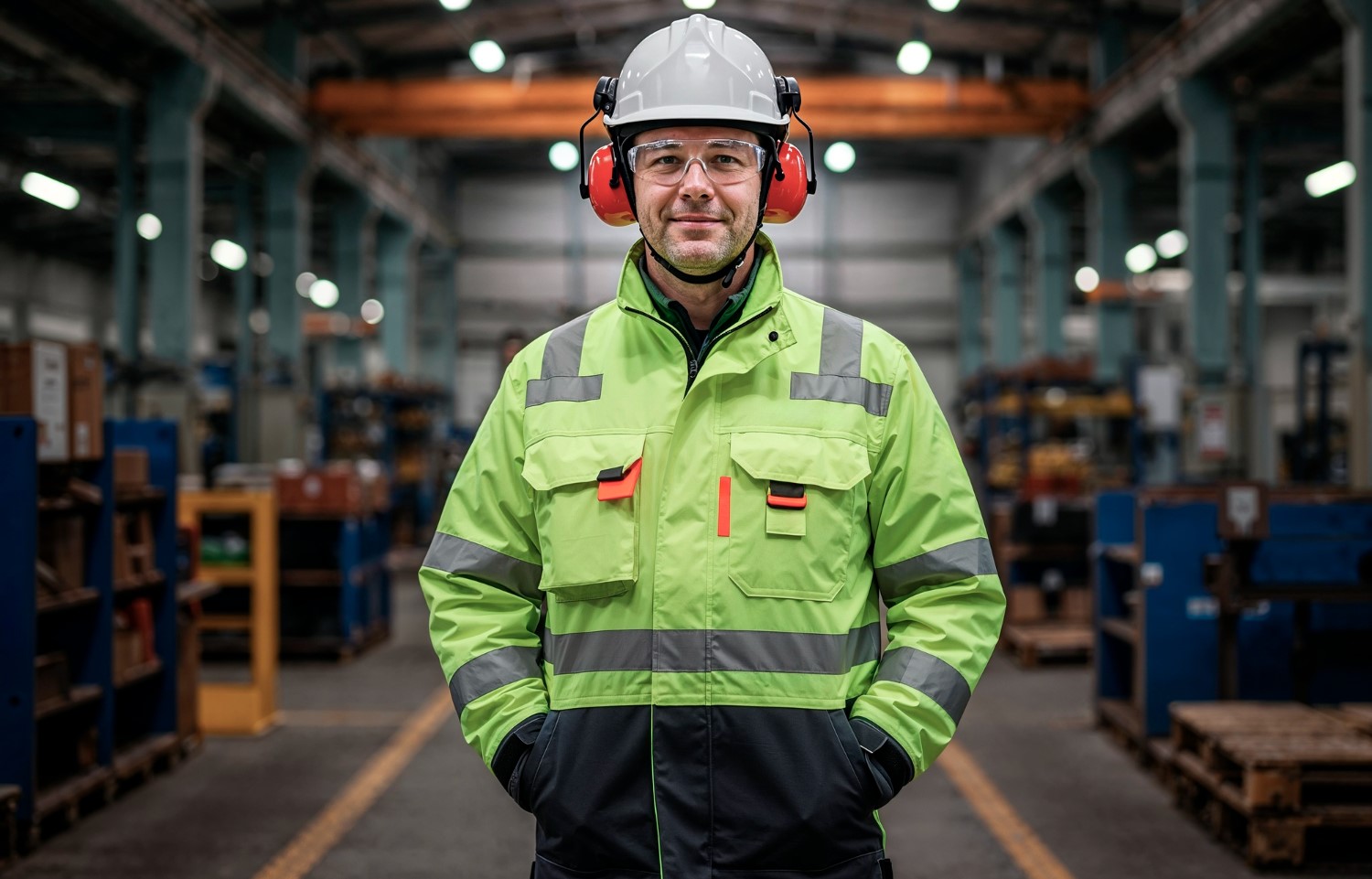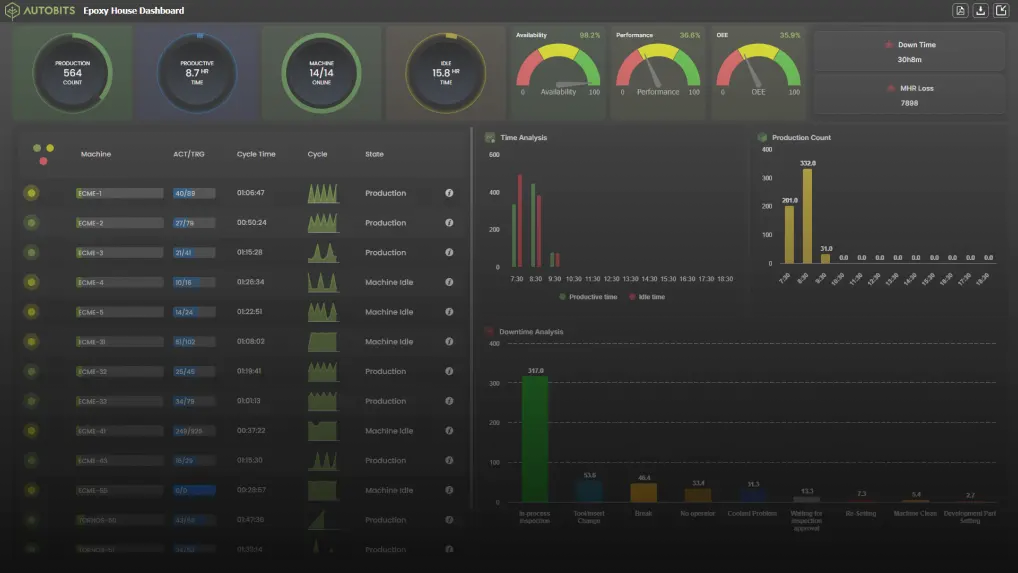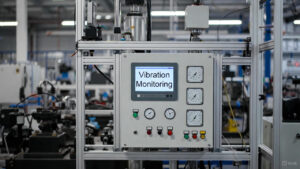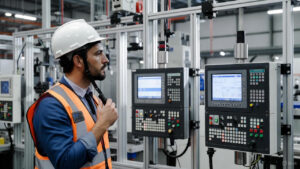Technology is changing the way factories work. Machines are getting smarter, processes are becoming faster, and data is helping manufacturers make better decisions every day. This transformation is known as factory automation.
In today’s world, factory automation is no longer limited to big industries. Even small and medium manufacturers are using it to improve production speed, reduce waste, and maintain quality. Automated systems can monitor machines, control production lines, and even predict when a part might need maintenance.
In this blog, we will explore factory automation, why it matters, and how it is shaping the future of manufacturing. You will also learn how Autobits Labs, a leading industrial technology company, is helping factories become smarter through IIoT (Industrial Internet of Things) and advanced automation solutions.
By the end of this blog, you will clearly understand:
- What factory automation means and how it works
- The technologies that make automation possible
- The primary benefits and challenges of automation
- How Autobits Labs is helping industries move toward smart factories
Let’s begin by understanding what factory automation really is.
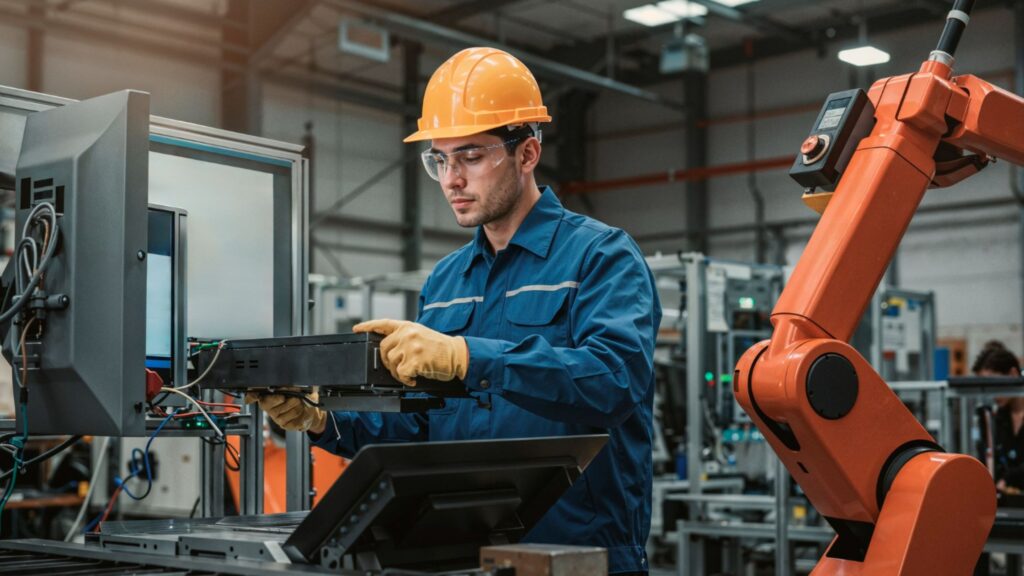
What is Factory Automation?
Factory automation is the process of using machines, control systems, sensors, and digital technologies to run manufacturing operations with little or no human involvement. The main goal is to make production faster, more efficient, safer, and more consistent.
In a traditional factory, many processes depend on manual labour. Workers control machines, move materials, and check product quality. In an automated factory, these jobs are handled by intelligent machines that follow programmed instructions, use real-time data, and make automatic adjustments whenever needed.
For example, imagine a packaging line where boxes are automatically filled, sealed, labelled, and checked for quality. The system uses sensors to detect any issue, such as a missing label or an underfilled box, and stops the machine for correction. This kind of automation saves time, reduces waste, and ensures every product meets the same quality standard.
How Factory Automation Works
Factory automation works by smartly combining hardware and software.
Here is how the process usually flows:
- Sensors collect data on machines’ temperature, pressure, speed, or vibration.
- Controllers like PLCs (Programmable Logic Controllers) use this data to make instant decisions.
- Actuators or Robots perform actions such as moving parts, cutting, or welding.
- Software Systems monitor and analyse the process, showing live performance data on dashboards.
- Cloud or IoT Platforms store and process this information to help managers make better decisions and plan maintenance schedules.
This continuous flow of data and control creates a self-monitoring system that can run efficiently without constant human attention.
Types of Factory Automation
There are three main types of factory automation based on flexibility and production needs.
1. Fixed Automation
Fixed automation is designed for high-volume production of a specific product. Machines are built to perform the same set of operations repeatedly, which makes them very fast and reliable, but not flexible.
Example: Automobile assembly lines where robots are used for welding, painting, or installing components.
2. Programmable Automation
Programmable automation allows changes in product design or process. Machines can be reprogrammed to make different types of products or variations.
Example: A packaging line that can switch between different bottle sizes or labels using new software settings.
3. Flexible Automation
Flexible automation allows factories to quickly adjust to changes in production or design. Systems use advanced software and data to configure machines for different tasks automatically.
Example: An electronics factory where robotic arms can adjust operations when a new circuit board model is introduced.
Core Components of Factory Automation
Factory automation systems are built using several key components that work together:
- Robots: Handle tasks such as welding, assembling, painting, or packaging.
- PLCs (Programmable Logic Controllers): Control machines and respond to signals from sensors.
- Sensors: Measure factors like temperature, vibration, and pressure for real-time monitoring.
- SCADA (Supervisory Control and Data Acquisition): A software system that displays live machine data and controls the production process.
- IoT Devices and Cloud Systems: Connect machines to the internet for data analysis, alerts, and remote monitoring.
- Human Machine Interfaces (HMIs): Touchscreen panels that allow operators to monitor and adjust systems easily.
These technologies work together to create a connected and intelligent factory where every device communicates and collaborates for better results.
Benefits of Understanding Automation
Knowing what factory automation is helps manufacturers plan more innovative production strategies.
It allows businesses to:
- Improve production efficiency
- Reduce labour costs and human errors
- Increase quality consistency
- Enhance safety for workers
- Collect data for better decisions
Factory automation is not about replacing people with machines. It is about creating a balance between human intelligence and machine efficiency, where people handle planning and problem-solving while machines take care of repetitive and time-sensitive work.
In Short
Factory automation is the foundation of smart manufacturing. It uses technology to connect every part of production, from machines to data systems, creating a setup where processes are faster, wiser, and more reliable. This is what we call the move toward Industry 4.0, where factories become digital, connected, and highly efficient.

Why Factory Automation Matters Today
Factory automation has become an essential part of modern manufacturing. It is no longer an option but a necessity for industries that want to stay competitive, reduce costs, and deliver consistent quality. In a world where speed, precision, and efficiency decide success, automation helps factories achieve all three together.
Let us understand why factory automation matters so much today.
1. Rising Demand for Quality and Speed
Customers today expect affordable products that are available quickly and made with high precision. Manual production often struggles to meet these expectations. Automation ensures that every product is made with the same level of accuracy, reducing defects and delays.
For example, automated filling machines in food factories maintain the exact quantity in every packet, avoiding overfilling or underfilling. This improves quality, reduces wastage, and builds customer trust.
2. Better Efficiency and Productivity
Automated systems work faster than humans and do not get tired. They can operate continuously for long hours while maintaining the same level of output, improving a factory’s overall productivity.
With intelligent automation, factories can track real-time production data, identify bottlenecks, and make instant changes to improve performance. This leads to better resource utilisation and higher production rates.
3. Cost Reduction and Waste Control
While automation requires an initial investment, it helps reduce long-term costs. Machines can perform repetitive tasks more efficiently, reducing the need for large labour teams. They also minimise material waste by maintaining consistent performance.
For example, automated cutting systems in textile or metal industries ensure precise measurements, which saves raw material and reduces scrap.
4. Enhanced Safety and Working Conditions
Automation helps create safer workplaces. Dangerous or repetitive tasks can be handled by machines instead of humans, reducing the risk of injuries and ensuring a better working environment.
For example, robotic systems can handle heavy materials or operate in high-temperature areas where human presence is risky. This not only protects workers but also allows them to focus on tasks that require decision-making and creativity.
5. Real-Time Data and Smarter Decisions
Modern automation systems are not just about machines working automatically. They collect large amounts of data from every part of the production line. This data helps factory managers monitor performance, track output, and identify areas for improvement.
With the help of IoT and cloud-based systems, this data can be viewed from anywhere. Managers can make decisions faster, plan maintenance schedules, and predict equipment failures before they happen.
6. Adapting to Industry 4.0
Factory automation is the foundation of Industry 4.0, also known as the Fourth Industrial Revolution. In this new era, factories are becoming more intelligent and more connected. Machines talk to each other, systems share data in real time, and artificial intelligence helps improve operations automatically.
By adopting automation, companies prepare themselves for digital transformation. It allows them to stay ready for future technologies such as AI-driven analytics, predictive maintenance, and entirely paperless factories.
7. Environmental Benefits
Automation also supports sustainability. When machines are optimised and monitored correctly, they consume less energy and reduce waste. Intelligent systems can track energy usage and help factories follow eco-friendly practices.
For example, energy monitoring systems in automated plants help identify which machines consume more power, so corrective actions can be taken to save energy and lower costs.
In Simple Words
Factory automation matters today because it helps manufacturers stay competitive, efficient, and sustainable. It improves product quality, enhances safety, saves money, and opens the door to more innovative and greener factories.
Automation is not about removing people from production. It is about giving them better tools to work smarter and achieve more with less effort.
Key Technologies Behind Factory Automation
A single technology does not power factory automation. It is an innovative combination of several systems that work together to make production faster, safer, and more reliable. These technologies help machines think, sense, and respond just like humans, but with better accuracy and speed.
Let’s look at the major technologies that make automation possible today.
Programmable Logic Controllers (PLCs)
PLCs are the backbone of most automated factories. They are small industrial computers that control machines and processes. A PLC can receive input signals from sensors, make decisions based on programmed logic, and send commands to machines to act.
For example, a PLC can control a conveyor belt to start or stop based on the position of a product detected by a sensor.
Benefits of PLCs:
- Reliable and built for harsh factory conditions
- Easy to program and modify as per production needs
- Fast and accurate response time
Human-Machine Interface (HMI)
HMI is the screen or dashboard that connects humans with machines. It allows operators to monitor the system, view performance data, and make quick adjustments.
Modern HMIs are touch-based, with colourful graphics and live status updates. They make it easier to control large production systems without needing complex technical knowledge.
Example: A plant operator can use an HMI screen to see which machines are running, how much output is being produced, and whether any machine requires maintenance.
Industrial Sensors
Sensors are like “eyes and ears” in an automated factory. They detect important conditions like temperature, pressure, speed, distance, or light.
These signals are then sent to PLCs or control systems, which make decisions automatically.
Common types of sensors used:
- Proximity sensors (detect object presence)
- Temperature sensors
- Pressure sensors
- Motion or vibration sensors
- Optical and laser sensors
Sensors ensure that machines work accurately and safely without human supervision.
Industrial Robots
Robots are one of the most visible parts of factory automation. They can handle repetitive or dangerous tasks with high speed and accuracy.
Different types of robots are used depending on the work type:
- Articulated robots for welding and painting
- SCARA robots for assembling small parts
- Collaborative robots (Cobots) that work safely alongside humans
Benefits of robots in factories:
- Increased precision and productivity
- Lower risk of accidents
- Consistent performance without fatigue
Industrial Internet of Things (IIoT)
IIoT connects all machines, devices, and sensors in a factory through the internet. This allows real-time data sharing and more intelligent decision-making.
For example, if a motor starts consuming extra power, the IIoT system can instantly alert the maintenance team.
Advantages of IIoT:
- Remote monitoring of equipment
- Early detection of faults
- Better energy management
- Reduced downtime
Artificial Intelligence (AI) and Machine Learning (ML)
AI and ML are helping factories move from automation to intelligent automation. These technologies allow systems to learn from data and improve performance automatically.
For example, AI can analyse production data to predict when a machine might fail. This helps prevent breakdowns and keeps the production line running smoothly.
Uses of AI and ML in automation:
- Predictive maintenance
- Quality control using image recognition
- Process optimisation based on real-time data
Supervisory Control and Data Acquisition (SCADA)
SCADA systems collect and monitor data from different parts of the factory. They help managers control large and complex systems from a single platform.
SCADA is beneficial for industries with multiple processes running simultaneously, such as power, water treatment, and manufacturing.
Benefits of SCADA:
- Centralized control
- Real-time data visualisation
- Quick fault detection and response
Cloud Computing and Data Analytics
Cloud technology allows factories to store and access their production data securely from anywhere. Combined with analytics tools, it helps companies make better business decisions.
For example, by studying production data, a company can identify which shift performs best or which machine consumes more energy.
Cloud-based systems also make collaboration easier across departments and locations.
3D Printing and Additive Manufacturing
In some factories, 3D printing is used to create prototypes, spare parts, or even final products. It allows quick design changes and reduces the need for traditional tooling.
This technology saves time and resources while enabling greater customisation in manufacturing.
Industrial Automation Software
Automation software integrates all the technologies. It helps design, simulate, and manage automated processes. Many companies use specialised software for scheduling, production tracking, and performance analysis.
Such software helps operators control multiple machines, plan production cycles, and monitor results from a single interface.
In Simple Words
Factory automation works because many smart technologies work together. From sensors and PLCs to AI and robotics, each technology improves speed, safety, and quality.
These innovations are what make modern factories more intelligent, efficient, and ready for the future.
Benefits of Factory Automation for Industries
Factory automation is transforming the way industries work. It is not just about using machines but about improving the entire production process from start to finish. Whether it is a small manufacturing unit or a large industrial plant, automation brings measurable benefits in productivity, quality, and cost savings.
Let’s explore the significant benefits that automation offers to industries today.
Higher Productivity and Output
Automated machines work faster than humans and can run 24 hours a day without breaks. This means factories can produce more in less time.
Automation also helps reduce delays between production stages because all processes are connected and managed through intelligent systems.
Example: In an automotive factory, robots can assemble parts continuously without stopping, helping the company efficiently meet high demand.
Consistent and Improved Product Quality
Humans can make mistakes when performing repetitive tasks, but machines follow the same process every time. Automation ensures that every product meets the same quality standards.
Sensors and AI-powered inspection systems can detect even the most minor defects that the human eye might miss. This helps maintain brand reputation and customer satisfaction.
Result: Fewer errors, higher precision, and uniform quality across all batches.
Lower Production Costs
While the initial setup of automation may require investment, the long-term savings are significant. Automated systems reduce material waste, energy consumption, and labour costs.
Factories can also save money on rework and rejected items since automated systems ensure better accuracy.
Example: A packaging company using automated filling machines saves raw material and reduces product wastage by maintaining exact quantities in every pack.
Increased Safety and Reduced Risk
Factory automation helps keep workers safe by handling hazardous, repetitive, or physically demanding tasks. Machines can work in high temperatures and noisy areas or safely handle heavy objects.
This allows human workers to focus on tasks that need skill, problem-solving, or supervision.
Example: Robots in metal-cutting plants handle sharp tools and hot materials, reducing the risk of injuries for human workers.
Real-Time Monitoring and Control
Modern automation systems allow managers to track every stage of production in real time. They can see which machines are running, where delays are happening, and how efficiently the line is performing.
Supervisors can use intelligent dashboards or mobile apps to control machines, schedule maintenance, and make quick adjustments to avoid downtime.
Result: Faster decisions, better performance, and improved reliability.
Better Resource Utilisation
Automation ensures that raw materials, energy, and workforce are used efficiently. Systems are designed to minimise waste, optimise energy usage, and provide maximum output from every resource.
For example, smart sensors can monitor electricity usage and automatically switch off idle machines to save power.
Scalability and Flexibility
Automated systems are easy to upgrade or expand as production needs grow. New machines or processes can be added without disrupting the entire setup.
Many automation systems can be reprogrammed to produce different products, making factories more flexible and adaptable to changing market demands.
Example: A factory producing one type of beverage can easily switch to another flavour or size by updating the system’s settings.
Data-Driven Decision Making
Automation generates large amounts of valuable data. This data helps managers analyse trends, identify problems, and plan improvements.
Data analytics help factories make informed decisions such as predicting demand, optimising maintenance schedules, and improving product design.
Result: Smarter decisions, reduced downtime, and continuous improvement.
Enhanced Customer Satisfaction
Automation helps factories meet delivery deadlines, maintain consistent quality, and offer competitive prices, which leads to better customer experiences.
When customers receive reliable products on time, their trust in the brand increases, leading to long-term loyalty and repeat business.
Environmental and Energy Benefits
Automation helps industries move toward sustainability. Machines that work efficiently use less energy and produce less waste. Intelligent monitoring systems can track emissions, energy use, and recycling processes.
Example: Energy-efficient automated systems in food processing plants reduce power use and prevent material waste, contributing to eco-friendly manufacturing.
In Simple Words
Factory automation brings a wide range of benefits, from higher productivity and lower costs to better safety and environmental care. It helps industries work smarter, not harder, and prepares them for a future where efficiency and innovation go hand in hand.
Automation does not replace humans. It helps them achieve more with fewer errors, making every factory a stronger and more competitive unit.
How Autobits Labs Helps Automate Factories
Autobits Labs is a leading technology company that specialises in turning traditional factories into smart, data-driven production units. Their solutions combine industrial IoT (IIoT) devices, advanced analytics, cloud platforms, and automation software to improve efficiency, quality, and operational insights.
In today’s manufacturing world, many factories face challenges such as machine downtime, inconsistent production, and a lack of real-time visibility. Autobits Labs addresses these issues by connecting machines, collecting and analysing data, and providing actionable insights.
About Autobits Labs
Autobits Labs is based in India and focuses on Industrial Internet of Things (IIoT) and factory automation solutions. Their mission is to help manufacturers embrace Industry 4.0, where every machine, process, and operator is connected and optimised.
By integrating modern technology with existing equipment, Autobits Labs allows factories to:
- Monitor production in real time
- Reduce operational downtime
- Improve productivity and efficiency
- Make data-driven decisions
Their solutions are designed for factories of all sizes, from small workshops to large industrial plants.
Key Automation Solutions Offered by Autobits Labs
Autobits Labs provides end-to-end solutions that make factory operations more innovative, safer, and more efficient.
IIoT Gateways (Smart Supervisor)
- IIoT Gateways connect legacy machines, sensors, and PLCs to the cloud.
- They support multiple industrial protocols such as Modbus, OPC UA, Siemens S7, and Fanuc.
- It can store data offline and automatically sync when connected to the network.
Example: A factory using older CNC machines can now monitor their performance in real time without replacing them.
Benefits:
- Connects all machines into a unified system
- Reduces installation costs
- Provides real-time machine insights
Factory Metrics Platform
- A web and mobile dashboard that displays live data on machines, production lines, and equipment.
- Tracks KPIs such as overall equipment effectiveness (OEE), machine uptime, and production counts.
- Integrates seamlessly with ERP systems to align production with business planning.
Example: A plant manager can view production performance from a tablet or smartphone, even if they are off-site.
Benefits:
- Centralised monitoring of factory operations
- Quick access to production insights
- Faster decision-making and problem-solving
Predictive Maintenance Solutions
- Collects machine data, including vibration, temperature, and pressure.
- Uses advanced analytics to predict equipment failures before they happen.
- Sends real-time alerts to maintenance teams to prevent unexpected downtime.
Example: A milling machine shows unusual vibration patterns, triggering maintenance before it breaks down.
Benefits:
- Reduced unplanned downtime
- Lower repair costs
- Extended life of machines
CNC Machine Monitoring
- Tracks performance of CNC machines, including spindle speed, feed rate, tool wear, and job completion time.
- Identifies bottlenecks and inefficiencies on the shop floor.
- Provides detailed reports to help improve productivity.
Example: Supervisors can identify which machines are slowing down production and take corrective action.
Experience the power of CNC Machine Monitoring Software. Book your free demo today and optimize your operations!
Benefits:
- Optimised machine performance
- Improved overall efficiency
- Accurate data for decision-making
Energy and Equipment Monitoring
- Monitors electricity usage and efficiency of machines in real time.
- Detects high energy consumption or underperforming equipment.
- Suggests adjustments to save power and reduce waste.
Example: A factory identifies machines that are consuming more electricity than necessary and takes corrective action to reduce energy costs.
Benefits:
- Lower energy bills
- Reduced environmental impact
- Better utilisation of equipment
Digital Twin and Paperless Factory Solutions
- Creates virtual replicas of machines and production lines for simulation and planning.
- Allows operators to test changes digitally before applying them in the real factory.
- Replaces paper-based logs with digital records for better accuracy and transparency.
Example: A plant can simulate production changes digitally and identify potential issues before implementing them on the shop floor.
Benefits:
- Safer experimentation
- Reduced human error
- Faster implementation of process improvements

Integration of IT and OT Systems
Many factories struggle to connect Operational Technology (OT) systems, such as machines and sensors, with Information Technology (IT) systems, such as ERP, MES, or inventory management.
Autobits Labs provides seamless integration that allows production data to flow from the shop floor to business systems automatically.
Benefits:
- Better coordination between operations and management
- Real-time business insights from production data
- Informed decisions based on accurate data
Real Impact on Factories
Autobits Labs’ solutions deliver tangible improvements for factories:
- Continuous monitoring of machines and processes
- Reduced downtime with predictive maintenance
- Improved production efficiency and quality
- Lower operational costs through energy and resource optimisation
- Real-time insights for faster and smarter decisions
Result: Factories become smarter, more efficient, and ready for Industry 4.0, where every machine and operator works together in a connected ecosystem.
Why Choose Autobits Labs
Autobits Labs is trusted by manufacturers because:
- Their solutions are scalable for factories of all sizes
- They offer end-to-end support from installation to analytics
- Their systems integrate with existing machines without costly replacements
- They focus on actionable insights, not just data collection
By leveraging Autobits Labs’ solutions, manufacturers can transform traditional factories into connected, automated, and high-performing production units.
Industries Using Autobits Labs’ Automation Solutions
Autobits Labs serves a wide range of industries that are moving toward digital transformation and more intelligent manufacturing. Every industry faces unique challenges, such as high downtime, quality control, energy waste, or limited visibility into operations. Autobits Labs provides customised solutions that perfectly fit these challenges.
Let’s explore how different industries benefit from their automation and IIoT systems.
Automotive Industry
The automotive industry depends heavily on precision, speed, and consistent quality. Even a small error can lead to significant production losses.
How Autobits Labs helps:
- Provides CNC machine monitoring to track performance in real time.
- Offers predictive maintenance to reduce downtime and avoid unexpected equipment failures.
- Uses factory metrics dashboards to monitor OEE (Overall Equipment Effectiveness).
- Helps integrate robots, sensors, and production data for seamless workflows.
Result: Automotive factories can produce more vehicles with higher accuracy and lower production costs.
Metal and Engineering Industry
Metal fabrication units, machining workshops, and engineering firms often face issues with tool wear, process delays, and inconsistent output.
How Autobits Labs helps:
- Enables real-time machine monitoring for lathes, milling, drilling, and cutting machines.
- Provides energy monitoring to identify inefficient machines.
- Uses digital twin technology to simulate and optimise production.
Result: Improved efficiency, reduced material waste, and better equipment utilisation.
Plastic and Packaging Industry
The plastic and packaging sectors require fast, continuous operations with tight control over material usage and cycle time.
How Autobits Labs helps:
- Monitors injection moulding machines and packaging lines in real time.
- Tracks machine parameters like temperature, pressure, and cycle count.
- Alerts operators if machines deviate from ideal settings.
- Provides reports to optimise material consumption and reduce downtime.
Result: Consistent production quality and lower material wastage.
Food and Beverage Industry
Factories in this sector must maintain hygiene, accuracy, and consistency in every production batch. Any slight variation can affect product taste, packaging, or shelf life.
How Autobits Labs helps:
- Offers energy monitoring and machine control systems for processing and packaging lines.
- Tracks production metrics and ensures batch traceability.
- Provides real-time dashboards to help supervisors maintain continuous quality checks.
Result: Better quality control, reduced wastage, and improved compliance with safety standards.
Electronics and Electrical Industry
The electronics industry demands high precision and timely delivery. Even small inefficiencies can cause significant losses.
How Autobits Labs helps:
- Monitors production lines and assembly systems for uptime and output.
- Integrates IoT sensors to track machine performance.
- Provides data analytics tools to identify performance trends.
Result: Faster production cycles, fewer errors, and better visibility into production performance.
Textile Industry
The textile sector often deals with long production cycles and energy-intensive machines. Efficiency and cost control are key.
How Autobits Labs helps:
- Provides energy monitoring systems to track consumption in weaving, dyeing, and finishing machines.
- Uses IIoT data to optimise shift performance and reduce idle time.
- Offers machine utilisation reports to improve planning and scheduling.
Result: Higher production efficiency and lower energy costs.
Pharmaceutical and Chemical Industry
In this industry, accuracy, consistency, and safety are the top priorities. Automation helps maintain strict process control and traceability.
How Autobits Labs helps:
- Implements digital data collection systems to reduce manual errors.
- Monitors critical machine parameters to ensure product consistency.
- Offers real-time alerts and detailed reports for compliance and auditing.
Result: Increased production reliability and full traceability of every batch.
Heavy Machinery and Industrial Equipment Manufacturers
These industries handle complex processes involving multiple machines and large production lines.
How Autobits Labs helps:
- Provides centralised factory dashboards for monitoring multiple machines.
- Uses predictive analytics to identify maintenance needs.
- Connects older equipment to modern systems using IIoT gateways.
Result: Improved coordination, reduced downtime, and better asset management.
Renewable Energy and Power Plants
Energy systems require continuous monitoring to ensure safety and efficiency.
How Autobits Labs helps:
- Provides energy and asset monitoring platforms.
- Tracks system health, power output, and equipment performance.
- Alerts teams about potential faults to prevent downtime.
Result: Increased uptime, safer operations, and better energy utilisation.
In Simple Words
Autobits Labs helps industries of all types adopt more innovative, more efficient manufacturing practices. Their solutions work for both new and existing factories, helping them connect machines, reduce downtime, and improve quality.
No matter the industry, Autobits Labs provides the same value: data-driven efficiency, cost savings, and a smoother path to Industry 4.0.
Read: Industry 5.0 vs Industry 4.0: What are the differences?
The Future of Factory Automation
Factory automation is evolving faster than ever before. What was once limited to mechanical machines and simple control systems has now transformed into a world of smart, connected, and intelligent factories. The future of manufacturing will be driven by technology that makes production faster, safer, more flexible, and environmentally friendly.
Let’s explore how automation will shape the factories of tomorrow.
Rise of Smart Factories
Smart factories are the next stage of industrial evolution. They are powered by artificial intelligence, IoT, machine learning, and cloud computing, all of which work together to make operations fully data-driven.
In these factories, every machine and process is connected. Data flows continuously from the shop floor to management systems, allowing decisions to be made in real time.
Example: Machines will be able to automatically adjust their speed or settings based on product demand or raw material availability without human intervention.
Impact: More productivity, better quality, and zero unplanned downtime.
Increased Use of Artificial Intelligence (AI)
AI will play a bigger role in every part of production, from predictive maintenance to process optimisation. AI systems can learn from historical data, detect patterns, and make automatic adjustments to improve efficiency.
Future applications of AI in automation:
- Predicting maintenance needs before any breakdown occurs
- Automatically adjusting machine settings for maximum output
- Improving quality control with vision-based defect detection
AI will make factories more intelligent and self-sufficient, reducing dependency on manual supervision.
Human and Robot Collaboration
In the future, factories will see more collaboration between humans and robots. These collaborative robots (cobots) are designed to work safely alongside humans.
Cobots will handle repetitive or heavy tasks, while human workers will focus on problem-solving, creativity, and supervision.
Example: A cobot might handle packaging, while an operator checks product quality. Together, they complete the task faster and more safely.
Impact: A perfect balance between human intelligence and robotic precision.
Greater Focus on Sustainability
Sustainability will become a significant goal in factory automation. Companies will invest in technologies that reduce energy use, minimise waste, and lower emissions.
How automation supports sustainability:
- Innovative energy monitoring systems reduce unnecessary power consumption.
- Automated processes ensure optimal use of materials.
- Predictive maintenance prevents resource loss due to breakdowns.
Result: Environment-friendly factories with lower operational costs.
Integration of Digital Twins
Digital twin technology is one of the most exciting innovations in industrial automation. It creates a virtual replica of a physical machine or system, allowing operators to test, simulate, and improve processes digitally before making changes in the real factory.
Example: Engineers can simulate a new production setup virtually to identify potential bottlenecks, saving both time and cost.
Digital twins will become a standard tool for designing, monitoring, and optimising factory operations.
Edge Computing and Faster Data Processing
As factories generate vast amounts of data, faster processing will become critical. Edge computing will process data closer to where it is generated, reducing delays and improving responsiveness.
Impact: Machines can react instantly to changes, and systems can make split-second decisions without waiting for cloud servers.
This will make automation more reliable, especially in time-sensitive operations such as assembly, inspection, and robotics.
Adoption of 5G Technology
5G connectivity will revolutionise factory communication by providing faster data transfer, lower latency, and more reliable networks.
This will allow thousands of connected devices to communicate simultaneously, enabling real-time coordination between machines, sensors, and control systems.
Result: Smoother operations, improved accuracy, and faster response to production changes.
Hyper-Automation
Hyper-automation combines AI, machine learning, robotic process automation (RPA), and IoT to automate not just physical tasks but also digital and decision-based processes.
In the future, factories will use hyper-automation to connect every part of their operations, from procurement and production to logistics and quality assurance.
Impact: Factories will become self-learning, self-correcting, and capable of operating with minimal human intervention.
Data-Driven Decision Making
The future factory will rely entirely on data for decision-making. From production scheduling to supply chain management, every move will be guided by insights derived from live data.
Managers will no longer rely on assumptions but on accurate, real-time information that ensures the best possible decisions.
Result: Greater transparency, improved efficiency, and more intelligent management at every level.
Enhanced Customisation and Flexibility
Automation will make it easier for factories to produce customised products quickly and efficiently. Instead of focusing only on mass production, future systems will allow mass customisation, where customers can get personalised products at the speed of large-scale manufacturing.
Example: A factory could switch between producing different product variants within minutes, without changing the entire setup.
Impact: Increased customer satisfaction and a more potent competitive edge.
In Simple Words
The future of factory automation is bright, sustainable, and human-friendly. Machines will not just follow commands but think, learn, and adapt.
Automation will empower humans to focus on innovation while technology handles precision and performance. Companies that invest in automation today will lead the way in tomorrow’s manufacturing world.

Conclusion and Key Takeaways
Factory automation has become the backbone of modern manufacturing. It transforms traditional production lines into innovative, efficient, and data-driven systems that deliver higher output, better quality, and improved safety.
From simple robotic arms to fully connected smart factories, automation helps industries reduce costs, eliminate errors, and meet the growing demand for faster and more flexible production. It not only changes how factories operate but also how they compete in the global market.
As we move toward Industry 4.0, technologies such as artificial intelligence, IoT, robotics, and digital twins are shaping the future of factories. These advancements will make manufacturing more intelligent, sustainable, and adaptable to changing needs.
However, it is also important to remember that factory automation is not about replacing humans. It is about empowering them to focus on creativity, innovation, and strategic decision-making while machines handle repetitive and precision-based tasks.
In short, automation balances human intelligence and machine efficiency. It builds a future where productivity, quality, and sustainability coexist.
Key Takeaways
- Factory automation uses technology to perform manufacturing tasks with less human involvement.
- It improves productivity, quality, and safety while reducing costs and human error.
- Different types of automation include fixed, programmable, and flexible systems.
- Benefits include faster production, better consistency, real-time monitoring, and efficient use of resources.
- Modern automation integrates technologies like AI, IoT, robotics, and digital twins.
- The future of automation focuses on smart factories, sustainability, and human-robot collaboration.
- Companies adopting automation today will gain a strong competitive advantage in the years ahead.
Final Thought
Factory automation is not just a trend; it is the future of manufacturing. As businesses adapt to new challenges and global competition, automation will be the key to achieving continuous growth and innovation.
By combining human creativity with technological intelligence, industries can build a smarter, safer, and more sustainable tomorrow.

